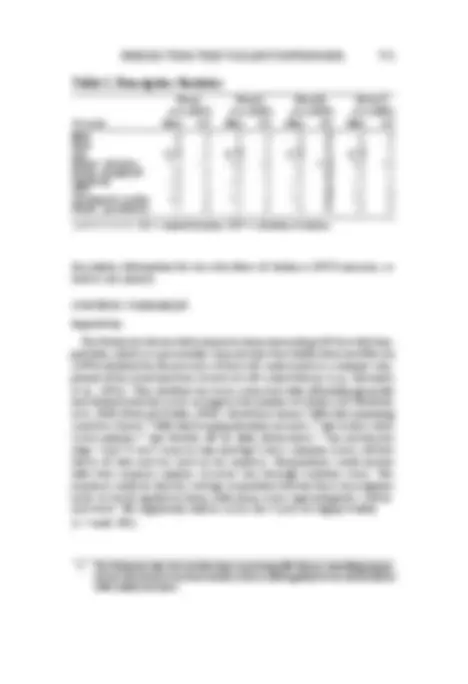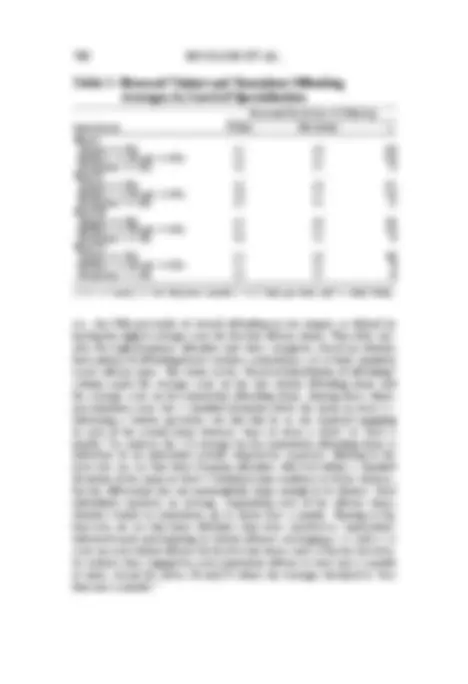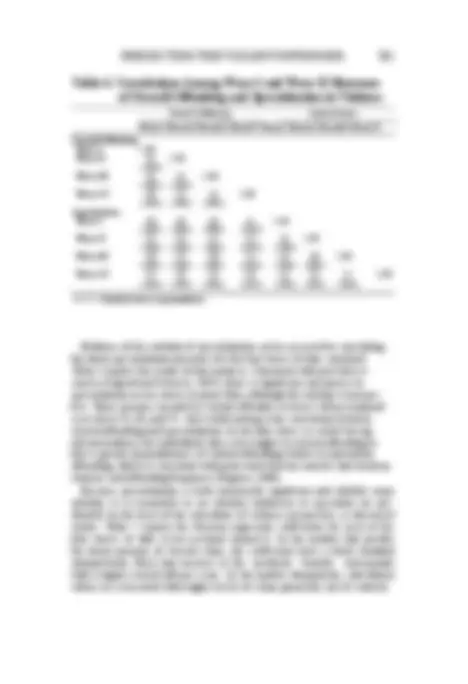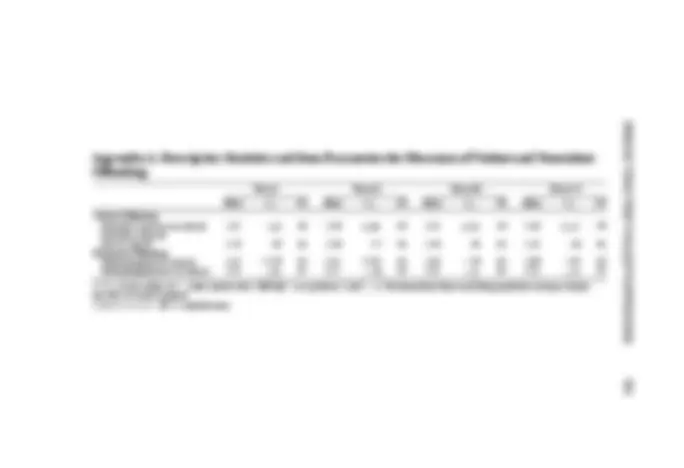






















Study with the several resources on Docsity

Earn points by helping other students or get them with a premium plan


Prepare for your exams
Study with the several resources on Docsity

Earn points to download
Earn points by helping other students or get them with a premium plan
Community
Ask the community for help and clear up your study doubts
Discover the best universities in your country according to Docsity users
Free resources
Download our free guides on studying techniques, anxiety management strategies, and thesis advice from Docsity tutors
Written by 4 criminal justice professors JEAN MARIE MCGLOIN, CHRISTOPHER J. SCHRECK, ERIC A. STEWART, GRAHAM C. OUSEY.
Typology: Papers
1 / 28

This page cannot be seen from the preview
Don't miss anything!





















∗
768 MCGLOIN ET AL.
Given the ample empirical attention directed at identifying what pro-
duces a violent offender, one might reasonably assume that criminologists
consider it a worthy area of inquiry. Indeed, the fact that such literature
guides the development and structure of intervention programs aimed at
curbing youth violence underscores this point (e.g., Reiss and Roth, 1993).
Yet there is a fundamental debate in criminology about the “uniqueness”
of the violent offender and, consequently, whether he deserves research
attention. Many leading criminological theorists are skeptical of the claim
that offenders specialize in any meaningful way, thus questioning the need
for theory to classify offenders based on the type of crimes they commit
or for policies to address supposedly unique proclivities (Felson, 1994;
Gottfredson and Hirschi, 1990; Hirschi and Gottfredson, 2008; Sampson
and Laub, 1993). Others disagree, however, arguing that some factors exist
that have special relevance in the etiology of violence, which are worthy
of attention and inquiry (e.g., Anderson, 1999; Wolfgang and Ferracuti,
1967). In the end, this debate is no small matter; at issue is the question
about what sort of criminological theory—general or specifc/typological—
the feld should pursue and value.
Even though the empirical literature has identifed a large stack of in-
dividual and social factors as purported predictors of violent offending, it
does little to clarify this debate. Most of these prior analyses have focused
on predicting the rate or frequency of violence, not on the portion of
the total offenses that are violent (e.g., Elliott, 1994; Piquero et al., 2005;
Stewart and Simons, 2006). This approach is effective insofar as it allows
researchers to identify predictors of violence, but it does so at the price of
being unable to establish which factors uniquely predict violence. Because
frequent offenders engage in violence, as well as exhibit many other forms
of antisocial behavior, studies of violence typically are not identifying a
distinct violent offender so much as predicting “violent offenses [that] are
essentially committed at random in prolifc criminal careers” (Farrington,
1998: 429; see also MacDonald, Haviland, and Morral, 2009).
This limitation is especially salient when considering theories that are
explicitly meant to identify violent offenders. Specifcally, determining
whether some offenders systematically favor violence and identifying fac-
tors that distinguish such people from others is of paramount importance
for assessing the validity of the subculture of violence perspective. This
framework asserts that the adherence to violent norms and beliefs should
identify individuals prone toward violence, not simply those who spo-
radically engage in violence as part of a versatile offending profle. Al-
though numerous studies have observed a relationship between violent at-
titudes/values and aggressive behavior (e.g., Baron, 2001; Hartnagel, 1980;
Heimer, 1997; Kubrin and Weitzer, 2003; Markowitz and Felson, 1998;
Stewart and Simons, 2006, 2010), they have focused only on violence as
770 MCGLOIN ET AL.
sought to explain a particular sort of deviant behavior: violence. Although
the people to whom the subculture of violence applies has varied—from
Southerners to African Americans and even to Scotch Irish clans settled
in Appalachian communities (Anderson, 1990; Dixon and Lizotte, 1987;
Fischer, 1989; Hackney, 1969; Messner, 1983; Nisbett and Cohen, 1996)—
the unifying core concept remains the same. Individuals who adhere to a
normative system that tolerates and endorses violence as a way of managing
social interactions and disputes have a systematic heightened proclivity for
being aggressive (Felson et al., 1994; Ousey and Wilcox,2005).
This perspective gained traction largely because of Wolfgang and Ferra-
cutti’s (1967) research on homicide rates in Philadelphia. Based on obser-
vations of differential homicide patterns, they argued that for some groups
of people in disadvantaged settings, violence is a frequent and normative
way of managing most dimensions of social life, from parenting, to romantic
relationships, to basic social exchanges. From the beginning, then, it is im-
portant to recognize that this theoretical premise was developed to explain
violence, but because Wolfgang and Ferracutti (1967) looked specifcally
at homicide trends, it was empirically unclear whether this subculture
discriminated violence from other forms of crime and deviance. Even so,
this perspective endured and several scholars offered their own versions
of the subculture of violence (see Bernard, 1990; Luckenbill and Doyle,
1989). Most recently, Anderson (1990, 1999) argued that an oppositional
subculture oriented around violence and aggression has developed in highly
disadvantaged neighborhoods, particularly among a segment of African
American residents.
The key goal among those who adhere to the subculture of violence
is the development and maintenance of a tough reputation, which when
compared with traditional middle-class markers of success such as edu-
cation and good employment, is relatively ephemeral, easily damaged, or
“stolen.” For instance, Anderson (1990) noted that Black youth in highly
disadvantaged circumstances can have their source of respect and success
snatched away in a momentary interaction, thereby forcing them to develop
a willingness to ward off perceived threats and reinforce this reputation. In
this way, for those who adhere to violent norms, mundane interactions that
are trivial at the outset can easily escalate into serious violence, given the
normative status aggression has with regard to interpreting and responding
to social situations. Several scholars have spoken about this subculture in
terms of the cognitive scripts that individuals import into situations and rely
on when interpreting and responding to social interactions (Luckenbill and
Doyle, 1989; Wilkinson and Fagan, 1996; see also Lee and Ousey, 2011).
Whereas someone who does not adhere to the subculture of violence may
view being bumped by a passerby as accidental or perhaps somewhat rude,
individuals who adhere to the subculture of violence are likely to interpret
PREDICTINGTHEVIOLENT OFFENDER 771
this bump as a sign of disrespect that demands an aggressive response.^2
Thus, whereas subculture of delinquency theories seek to identify individ-
uals who are more likely to engage in deviance than their counterparts,
the subculture of violence framework is invested in explaining why some
individuals are more likely to appeal to violence.
As stated, most prior studies testing the validity of the subculture of
violence have focused on explaining variation in measures of the overall
level of violence, not the extent to which violence is more or less prevalent
in relation to other types of offending behavior. For instance, Stewart,
Simons, and Conger (2002: 813) studied the neighborhood and psycholog-
ical predictors of violence among a sample of African American youth.
They measured whether subjects subscribed to a street code according to
the level of agreement with statements, such as “people will take advantage
of you if you don’t let them know how tough you are” and “people tend
to respect a person who is tough and aggressive.” Their results demon-
strated a positive relationship between adherence to the street code and
violent behavior (see also Stewart and Simons, 2006). Because no other
outcomes were considered, however, it remains unclear whether the street
code primarily promotes violence or whether it simply leads to a higher
overall rate of general offending, of which violence is one component.
This same issue applies to the majority of empirical work testing the
subculture of violence (e.g., Baron, Kennedy, and Forde, 2001; Bernburg
and Thorlindsson, 2007; Markowitz and Felson, 1998; Stewart and Simons,
2010).
Perhaps the closest acknowledgment of this problem is found in the
work of Felson et al. (1994), who examined whether the subculture of
violence predicted violent as well as nonviolent crime (theft and vandalism).
They found that an adherence to the subculture of violence increased
the likelihood of engaging in violence, as well as in nonviolent criminal
behaviors, which argues against this perspective as a “specialist” theory of
violent offending (see also Bernburg and Thorlindsson, 1999). They stated:
“[V]alues regarding violence generally predict other forms of delinquency
as well as they predict violence. Previous research on the subculture of
violence does not concern itself with this issue since it never examines other
forms of delinquent behavior” (Felson et al., 1994: 168). The question then
emerges, is the fact that the subculture of violence predicts nonviolent crime
PREDICTINGTHEVIOLENT OFFENDER 773
DATA AND METHODS
DATA
Data for this study were drawn from the Rural Substance Abuse and
Violence Project (RSVP), a prospective four-wave panel study of adoles-
cents residing in the state of Kentucky (NIDA Grant DA-11317) during
the period between 2001 and 2004. The RSVP project data were collected
initially in the spring of 2001 when the sample was in the seventh grade,
and subsequent measurements took place during the spring of the next
three years. The RSVP sample involved a multistage procedure with a ran-
dom selection of 30 (of 120) counties drawn from population-based strata.
Within the 30 selected counties, each of the 74 public schools with seventh
graders was contacted and access was granted by 65 schools. The targeted
population was 9,488 seventh graders enrolled in those 65 middle schools
at the initiation of the study. Active parent consent was required because
underage study participants were identifed and followed across multiple
years. Using a “Dillman method” for mailed surveys (Dillman, 1978), ac-
tive consent was granted by 43 percent of parents, leaving 4,102 sample
participants with parental approval. Using mass administration methods
at the participating schools, completed surveys were obtained from 3,
students in wave I and 3,638 students in wave II. In waves III and IV, after
most students had traversed from the originally sampled middle schools
into their local high school, completed surveys were obtained from 3,
and 3,040 respondents, respectively. Across the 4 years of study, at least
one observation was recorded for 3,976 of the original 4,102 respondents
whose parents granted active consent.^4
DEPENDENT VARIABLES
Our outcome measures are based on four self-report items measuring ap-
proximately how frequently within the current school year the respondent
physically attacked someone else or had stolen someone else’s money or
property, with separate items for offending at school and away from school.
Responses are coded using an ordinal metric: 1 = never, 2 = less than once
a month, 3 = approximately once a month, 4 = approximately 1–2 times
per week, and 5 = daily or almost daily.^5 As is typical with offense data,
774 MCGLOIN ET AL.
the responses are positively skewed, with most respondents reporting they
had not engaged in any of the offense activities (the mean scores for each
item in all four waves are reported in appendix A). Confrmatory factor
analyses show that the offense items load well onto the primary factor, thus
showing that they are statistically homogeneous; however, the second factor
loading also shows some evidence of distinctiveness between the violence
and nonviolence items. That is, even though all offense measures are pos-
itively correlated with each other, the violence items are somewhat more
strongly correlated with other violence items than they are with nonviolent
items, with a similar pattern unfolding for the nonviolent items. As Osgood
and Schreck noted (2007: 287–8), this pattern is consistent with the basic
assumptions of their approach, where the data reveal latent variables for
both overall offending and specialization in violence.
INDEPENDENT VARIABLE
Subculture of Violence
The Kentucky data contained four items that are suitable for our pur-
poses (see also Ousey and Wilcox, 2005). These items ask respondents
their level of agreement with the following: “Beating up other kids to gain
respect,” “beating up others who call you a dirty name,” “beating up others
who start a fght with you,” and “hitting other people is acceptable to get
what one wants.” Responses were coded as 1 (^) =strongly disagreethrough
(^4) =strongly agree. Respondents indicated that, on average, they disagreed
with these value statements, with mean scores hovering around 1.70 for
all four waves. Alpha reliability tests indicate a generally acceptable level
of internal consistency for our street codes measure across waves ( α (^) =
mid- .70s for waves I through III and .64 for wave IV).^6 Table 1 contains
776 MCGLOIN ET AL.
Friends’ Specialization in Violence
Given the robust relationship between deviant peers’ attitudes and vari-
ous dimensions of offending behavior (Warr, 2002), we control for friends’
tendency to specialize in violence, which measures the contrast between
reported violent and nonviolent offending. The index comprised two items,
which ask how many friends 1) stole something and 2) physically attacked
someone. Having at least one friend who attacked someone increased the
friend’s violent specialization index score by 1, whereas having at least one
friend who engaged in theft reduced the index score by 1. The mean friends’
specialization scores were approximately+.15 across each of the four
waves. Although this index has obvious potential theoretical signifcance
(e.g., differential association theory), we only employ this item as a control,
given that there are legitimate concerns about the validity of respondents’
claims about their friend’s behavior (Gottfredson and Hirschi, 1990; Haynie
and Osgood, 2005).^8
Maternal Attachment
Maternal attachment is an item often linked with offending (e.g., Hirschi,
1969), although not necessarily specialization. Attachment to mother is
based on the average response by subjects to four items: mother under-
stands me, mother makes me feel wanted, I share my thoughts with mother,
and I talk to my mother. Scores range from 1 (never) through 5 (always),
with mean scores being fairly consistent across the waves (from 3.8 through
4.0, meaning that the children felt that these statements “often” character-
ized their relationships with their mother).
Demographic Measures
Our analysis also incorporates the standard demographic controls: so-
cioeconomic status, age, race (1 (^) = African American), and gender (1 =
male). We have two measures of socioeconomic status: parental education
and parental unemployment. For parents’ education, we selected the parent
with the higher level of education because many children only have one
parent. This ordinal variable ranges from 1 (grade school or less) to 7
(graduate or professional school). Parents’ unemployment reports whether
at least one parent was unemployed for a given wave (1 = yes and 0 = no).
PREDICTINGTHEVIOLENT OFFENDER 777
During the 4 years of observation, these measures remained consistent. The
average respondent had at least one parent with some college education,
and parental unemployment ranged from 5 percent to 10 percent. Age is a
continuous measure, with the average respondent 13.4 years old at wave I.
Race was coded as 1 African American (0 all others), and gender was= =
coded as 1 male and 0 female. Approximately 48 percent of the sample= =
was male and 5 percent were African American. As with the socioeconomic
status (SES) measures, the demographic profles across each wave did not
meaningfully change.
ANALYTIC METHODS
Our statistical approach uses Osgood and Schreck’s (2007) item response
theory (IRT)-based statistical model for detecting specialization in offend-
ing. As this approach has been employed in several studies to date (e.g.,
Schreck, McGloin, and Kirk, 2009; Schreck, Stewart, and Osgood, 2008;
Sullivan et al., 2009), the presentation will only describe the main features
of the model.
The Osgood and Schreck model incorporates two levels of analysis,
where individual offense items are nested within individual subjects.^9 The
level 1 model works to defne two latent measures that are the focus of
the analysis: overall offending ( β (^) 0 j ) and offending specialization ( β (^) 1 j ). To
defne the specialization index, the model includes a group-mean-centered
dummy variable, “Spec,” which takes on positive scores for violent offense
items and negative scores for nonviolent offense items. The coeffcient as-
sociated with this specialization variable reports the difference in the log of
the expected event-rate for violent offense items to the log of the expected
i = 2
PREDICTINGTHEVIOLENT OFFENDER 779
Table 2. Reliability and Variance of Overall Offending and
Specialization
Wave I Wave II Wave III Wave IV Overall Offending Reliability Variance ( τ ) Specialization Reliability
Variance ( τ ) 5_._ 89(. 38) 6_._ 46(. 42) 6_._ 92(. 54) 8_._ 05(. 78)
NOTE: Standard errors of τ in parentheses.
RESULTS
Our frst step is to determine whether specialization in violence exists to a degree that is statistically signifcant and is relatively stable over time (see also Osgood and Schreck, 2007; Sullivan et al., 2009). Table 2 reports the variances, standard errors, and reliability scores for the two latent variables defned by the level 1 measurement model: overall offending and specialization. Some prior research has found that reliability scores for overall offending are relatively high (i.e., in the .70–.80 range; see Osgood and Schreck, 2007); however, our scores for each of the four waves are com-
paratively low and are more consistent with those reported in Sullivan et al.
(2009). Previous research using the IRT method suggests that specialization
is relatively unreliably measured, owing to the relatively few members of
the sample who self-report much offense activity, and the reliabilities of
the specialization index in the RSVP data conform to this expectation. The
implication of this is that specialization becomes more diffcult to detect
and predict largely because of the limited information coming from most of
the sample (i.e., we are dealing with a lot of zeroes or ones in these data).
An approach that can take this into account, such as our latent variable
approach, can alleviate this problem while using data from everyone in the
sample. To assess the statistical signifcance of the degree of specialization
in the sample, we compute a z score by obtaining the ratio of the variance
component to its standard error. For all four waves, the ratio exceeds 10,
indicating that there is statistically signifcant differentiation in individual
offense patterns from the population base-rates (i.e., specialization), with
less than a .0001 probability that the observed pattern is a function of
chance.
Table 3 provides one illustration of the variation in offending special- ization, focusing on the most frequent offenders in the Kentucky data
780 MCGLOIN ET AL.
Table 3. Observed Violent and Nonviolent Offending
Averages, by Level of Specialization
Observed Distribution of Offending
Specialization Violent Nonviolent (^) n Wave I Violent ( > 1 SD) 3.5 1.0 140 Neither ( > – 1 SD and < 1 SD) 3.3 2.3 120 Nonviolent ( < – 1 SD) 2.1 3.5 37 Wave II Violent ( > 1 SD) 3.3 1.0 145 Neither ( > – 1 SD and < 1 SD) 2.9 2.5 163 Nonviolent ( < – 1 SD) 1.3 3.2 16 Wave III Violent ( > 1 SD) 2.6 1.0 142 Neither ( > – 1 SD and < 1 SD) 2.6 2.3 123 Nonviolent ( < – 1 SD) 1.0 2.2 33 Wave IV Violent ( > 1 SD) 2.6 1.0 104 Neither ( > – 1 SD and < 1 SD) 2.5 2.4 79 Nonviolent ( < – 1 SD) 1.0 2.1 20
NOTE: 1 = never, 2 = less than once a month, 3 = 1–2 times per week, and 4 = almost daily.
(i.e., the 90th percentile of overall offending in our sample, as defned by
having the highest average score for the four offense items). This table clas-
sifes the high-frequency offenders into three categories, based on whether
their pattern of offending favors violence, nonviolence, or is fairly equitable
across offense types. The values in the “observed distribution of offending”
column report the average score on the two violent offending items and
the average score on the nonviolent offending items. Among those whose
specialization score was 1 standard deviation above the mean in wave I—
indicating a violent specialist—we fnd that he or she reported engaging
in each of the assault items between “once or twice a week” to “once a
month.” In contrast, the 1.0 average for the nonviolent offending items is
indicative of no nonviolent activity whatsoever (1 never). Moving to the=
next row, we see that those frequent offenders who fell within 1 standard
deviation of the mean in wave I exhibited some tendency to favor violence,
but the differential was not meaningfully large enough to be distinct. Such
individuals reported, on average, committing each of the offense items,
whether violent or nonviolent, up to about once a month. Turning to the
fnal row, we see that those offenders who were classifed as “nonviolent”
indicated rarely participating in violent offenses (averaging a 2.1 and a 1.
score on each violent offense for the frst two waves and 1.0 for the last two).
In contrast, they engaged in each nonviolent offense at least once a month
or more, except for waves III and IV where the averages declined to “less
than once a month.”
782
Table 5. Relationships of Explanatory Variables to Overall Offending and Specialization from
Poisson-Based Hierarchical Linear Model, Cross-Sectional Models
Wave I Wave II Wave III Wave IV
Overall Overall Overall Overall Crime Specialization Crime Specialization Crime Specialization Crime Specialization
Variables γ SE γ SE γ SE γ SE γ SE γ SE γ SE γ SE
Male_._ 62 ∗^ .13 −. 19 .20_._ 53 ∗^ .14 −. 29 .21_._ 67 ∗^ .16 −. 31 .23_._ 60 ∗^ .19_._ 32. Black_._ 45 .27_._ 10 .37_._ 65 ∗^ .27_._ 33 .42_._ 97 ∗^ .29 −. 38 .44_._ 97 ∗^ .40 −. 73. Age_._ 12 .11 −. 10 .17_._ 02 .12 −. 07 .19_._ 13 .15_._ 37 .21_._ 35 .18 −. 27. Parents’ education_._ 04 .04 −. 05 .06_._ 03 .04 −. 03 .06 −. 01 .05 −. 05 .06_._ 12 ∗^ .06 −. 04. Parents unemployed_._ (^06) .20 −. 56 .29_._ 49 .28 −. 72 .39_._ 57 .34_._ 27 .58_._ 11 .42 −. 55. Impulsivity_._ 71 ∗^ .09 −. 29 ∗^ .13_._ 78 ∗^ .10 −. 22 .14_._ 77 ∗^ .11 −. 17 .14_._ 72 ∗^ .13_._ 04. SOV_._ 99 ∗^ .09 −. 05 .13 1_._ 00 ∗^ .10_._ 19 .13 1_._ 10 ∗^ .12_._ 29 .15 1_._ 81 ∗^ .14 −. 18. Attachment to mother −. 45 ∗^ .06_._ 17 .09 −. 48 ∗^ .07_._ 05 .11 −. 34 ∗^ .09 −. 01 .11 −. 37 ∗^ .10 −. 02. Friends’ specialization_._ 12 .13 1_._ 68 ∗ .20_._ 11 .16 2_._ 71 ∗ .27 −. 20 .17 2_._ 19 ∗ .28_._ 21 .21 1_._ 86 ∗.
NOTE: γ is the hierarchical linear modeling population average estimate, and SE is its robust standard error. ABBREVIATIONS: SE (^) = standard error; SOV (^) =subculture of violence. ∗ p < .05.
MCGLOIN ET AL.
PREDICTINGTHEVIOLENT OFFENDER 783
Additionally, being male, having weak maternal attachment, and impulsiv-
ity are also related with higher levels of (general) illegal behavior.
The most important question, however, is whether the independent vari-
ables are associated with the tendency to favor violence over nonviolence.
As noted earlier in our description of the models, regression coeffcients
in the specialization equation indicate how each unit change in a predic-
tor variable affects the ratio of violent-to-nonviolent offenses. Our key
theoretical hypothesis concerned subcultural values, which we predicted
would be associated with a tendency to specialize in violent behavior. This
prediction was not supported in any of the waves. Children who reported
stronger beliefs in the use of violence were statistically neither more nor less
likely to engage in violence than other subjects, although they engaged in
more crime overall. The only measure to predict specialization tendencies
consistently was the tendency for friends to specialize, and this measure
did so in all four waves. This measure is somewhat risky to interpret,
however, because of the possibility that respondents could, at least partly,
be projecting their own qualities on their friends (see Haynie and Osgood,
2005). In short, although there is a signifcant tendency for many offenders
to specialize, our models do not consistently detect the reasons why, at least
among our key substantive predictors.^13
PREDICTINGTHEVIOLENT OFFENDER 785
the same measure of subculture of violence beliefs does predict counts of violence (see appendix B). Had this been our plan of analysis, this study likely would have been added to the pile of those supportive of this theo- retical perspective. But, by relying on a method that distinguishes between general offending and violence specialization, it becomes clear that such models and fndings can be deceptive. Our fndings therefore stand in contrast to the core premise—if not the very name—of the subculture of violence. The primary reason why this theoretical perspective stood out from other subculture of deviance per- spectives was that it focused on identifying and describing the reasons for heightened violence among particular pockets of society. Yet, our results suggest that these supposed etiological factors and processes are instead identifying heightened levels offending, of which violence is a part.^14 To be clear, we are not joining other scholars in criticizing the subculture of violence perspective on the grounds that tendencies to specialize in violence do not exist (see Gottfredson and Hirschi, 1990)—they do. Rather, we are troubled by the fnding that measures refective of this perspective do not identify these tendencies (at least in the data used here). For decades, scholars have been skeptical of the empirical validity of the subculture of violence (e.g., Dixon and Lizotte, 1987; Erlanger, 1974; Felson et al., 1994; Gottfredson and Hirschi, 1990; Loftin and Hill, 1974), and the current study joins these voices. Given the now increasing evidence that at least some individuals “spe- cialize” in violent offending, the question now turns to what theories and constructs contained therein can predict a tendency to favor violent over nonviolent offending. Recent work confrming the presence of a latent tendency to favor violent offending largely has been atheoretical (e.g., Osgood and Schreck, 2007; Sullivan et al., 2009), and our analysis questions
a “usual suspect” as a consistent and dominant explanation of this special-
ization (i.e., the subculture of violence). Although not specifcally focused
on violence, other work on specialization has increasingly highlighted the
importance of opportunity structures in shaping crime profles, even if the
motivation for such behavior stems from an enduring propensity (McGloin
et al., 2007; McGloin, Sullivan, and Piquero, 2009). As work continues on this front, incorporating a situational perspective may turn out to be a fruitful direction of development (see also Wikstr o¨ m, 2006). Although we believe this study poses signifcant challenges to the pre- dictive validity of the subculture of violence premise, we recognize that
786 MCGLOIN ET AL.
additional work is necessary to overcome the limitations of this piece. First,
many respondents in our data are youth drawn from a rural setting. Many
subculture of violence perspectives were developed to explain behavior
among residents in disadvantaged urban communities (although some also
were applied to rural communities; see Ayers, 1991; Nisbett and Cohen,
1996). Although our data certainly cover some signifcantly disadvantaged
geographic areas, it would be benefcial for future work to replicate our
analysis with data sets that capture youth who reside in more urban environ-
ments. Second, our data covered 4 years, but the sample was young (12–
years old on average across the years). Given that we know crime patterns
shift with age, as can the factors and mechanisms implicated in producing
offending, replicating this analysis with samples that extend further into
adulthood would provide an important assessment of the robustness of the
current fndings. Finally, we would be remiss to ignore that our measures
of offending are based on self-reports. Although scholars often favor self-
reports over offcial records of crime when studying offending behavior, it
is possible that youth were reticent to report whether they had attacked
another person, perhaps more so than whether they had stolen another’s
property. Of course, social desirability also may have led them to overreport
violence as a means of “looking tough.” In the end, all self-reports are
limited by such concerns as recall errors, lying, and telescoping—our data
are no different. Therefore, it would be ideal to confrm the results here
with alternative outcome measures.
For substantive reasons, this research was focused on the contrast
between assaults and thefts. Other theories make different distinctions,
such as between white-collar crime and other crimes (e.g., Friedrichs and
Schwartz, 2008), and to consider these claims was beyond the scope of
this article. Nevertheless, given appropriate data, these questions are just
as important and Osgood and Schreck’s (2007) approach can help assess
the validity of these theoretical claims. Future research could therefore
extend both measures used here to capture violence and nonviolence as
well as to clarify the extent to which some individuals favor other crime
“types” and whether such tendencies coincide with theoretical predictions
or established risk factors.
REFERENCES
Anderson, Elijah. 1990. StreetWise: Race, Class, and Change in an Urban
Community. Chicago, IL: University of Chicago Press.
Anderson, Elijah. 1999. Code of the Street: Decency, Violence, and the Moral
Life of the Inner City. New York: Norton.